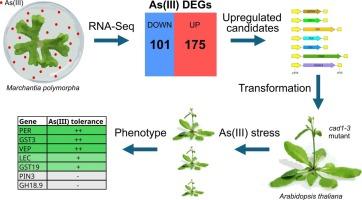多形苋和拟南芥耐砷机制部分保存的功能证据
IF 11.3
1区 环境科学与生态学
Q1 ENGINEERING, ENVIRONMENTAL
引用次数: 0
摘要
砷是一种广泛存在的类金属,即使浓度很低,对大多数植物也有剧毒。虽然维管植物中与砷耐受性相关的转录反应已被广泛研究,但对其姐妹系苔藓植物的了解相对较少。最重要的是,在这两个古老的分化的陆地植物谱系中,相同的基因是否在砷耐受性反应中起主要作用的功能证据目前在很大程度上缺乏。在这项研究中,我们通过RNA-Seq鉴定了一组高度可靠的差异表达基因(DEGs),这些基因在模式苔藓植物多形地菜(Marchantia polymorpha)中响应亚砷酸盐毒性。以管生植物为代表的拟南芥(Arabidopsis thaliana)对砷高度敏感的cad1-3突变体为研究对象,通过农杆菌介导的转化,探讨了7个基因表达上调的DEGs的功能保护进化水平,并对转基因品系干生物量的鲜重、丙二醛产量和总砷含量进行了表征。虽然两种测试的多态m.a多态基因没有显著提高砷耐受性,但其余5种基因在cad1-3中过表达时,给予WT col0植株最大的耐受性水平,以生物量积累衡量,在56%到100%之间。其中,1-cys过氧化物还蛋白恢复了植物的生长、保护脂质过氧化和积累砷的能力,使其恢复到与wt没有区别的水平。这些结果为多形拟南芥和拟南芥之间相当程度的砷耐受性反应保守性提供了功能证据,表明多形拟南芥可以作为鉴定进化深度保守基因的有效模型,用于作物的砷耐受性遗传改良。本文章由计算机程序翻译,如有差异,请以英文原文为准。

Functional evidence for the partial conservation of arsenic tolerance mechanisms in Marchantia polymorpha and Arabidopsis thaliana
Arsenic is a widespread metalloid that even at low concentrations is highly toxic to most plant species. While the transcriptional responses associated to arsenic tolerance have been widely investigated in vascular plants, comparatively little is known in their sister lineage, the bryophytes. Most importantly, functional evidence of whether the same genes play major roles in arsenic tolerance responses in these two anciently diverged land plant lineages is currently largely missing.In this study, we identified by RNA-Seq a highly reliable set of differentially expressed genes (DEGs) responding to arsenite toxicity in the model bryophyte Marchantia polymorpha. We then explored the evolutionary level of functional conservation of seven upregulated DEGs by Agrobacterium-mediated transformation in the highly arsenic-sensitive cad1-3 mutant of Arabidopsis thaliana as a representative of tracheophytes, and characterized fresh weight, malondialdehyde production and total arsenic content in dry biomass of transgenic lines.While two of the tested M. polymorpha DEGs did not significantly enhance arsenic tolerance, the remaining five DEGs, when overexpressed in cad1-3, conferred maximal levels of tolerance, measured as biomass accumulation, between 56% and 100% of WT Col-0 plants. Among them, a putative 1-cys peroxiredoxin restored growth, protection from lipid peroxidation and capacity to accumulate arsenic to levels indistinguishable from those of WT.These results provide functional evidence for the considerable conservation of arsenic tolerance responses between M. polymorpha and A. thaliana, suggesting that M. polymorpha can be a valid model for the identification of evolutionary deeply conserved genes for the genetic improvement of crops for arsenic tolerance.
求助全文
通过发布文献求助,成功后即可免费获取论文全文。
去求助
来源期刊

Journal of Hazardous Materials
工程技术-工程:环境
CiteScore
25.40
自引率
5.90%
发文量
3059
审稿时长
58 days
期刊介绍:
The Journal of Hazardous Materials serves as a global platform for promoting cutting-edge research in the field of Environmental Science and Engineering. Our publication features a wide range of articles, including full-length research papers, review articles, and perspectives, with the aim of enhancing our understanding of the dangers and risks associated with various materials concerning public health and the environment. It is important to note that the term "environmental contaminants" refers specifically to substances that pose hazardous effects through contamination, while excluding those that do not have such impacts on the environment or human health. Moreover, we emphasize the distinction between wastes and hazardous materials in order to provide further clarity on the scope of the journal. We have a keen interest in exploring specific compounds and microbial agents that have adverse effects on the environment.
 求助内容:
求助内容: 应助结果提醒方式:
应助结果提醒方式:


